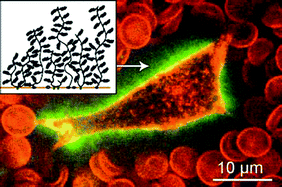Mapping the mechanics and macromolecular organization of hyaluronan-rich cell coats†
Abstract
The hyaluronan (HA)-rich pericellular coat (PCC) enveloping most mammalian cells plays a vital role in biological processes such as cell adhesion, proliferation, motility and embryogenesis. In particular its presence on chondrocytes, which live in the load-bearing cartilage, has a wide range of implications in diseases such as osteoarthritis, highlighting its mechanical role in living organisms. Despite its significance, the macromolecular organization of the cell coat remains speculative. In order to obtain a more detailed spatial picture of highly hydrated PCCs, we present two independent but complementary non-invasive techniques for the position-resolved analysis of the cell coat's mechanical and structural properties. Position-dependent microrheology provides a micromechanical map of the PCC that reveals a gradient of increasing elastic stiffness towards the plasma membrane on model rat chondrocyte cells (RCJ-P). This gradient can be correlated with the relative distribution of HA, which is inferred using an eGFP-labelled neurocan-binding domain, a small fluorescent molecule that binds to HA. The spatial variation of the HA concentration profile is consistent with the position-dependent elasticity. Combining these approaches sheds light on the molecular architecture of the PCC.


 Please wait while we load your content...
Please wait while we load your content...